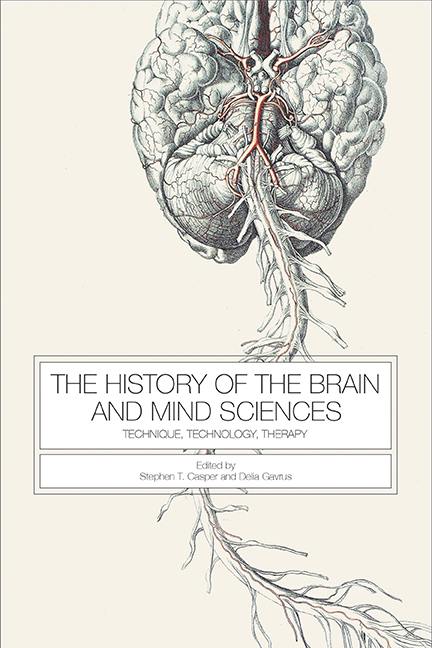Book contents
- Frontmatter
- Contents
- Acknowledgments
- Introduction
- 1 “We Are Veritable Animals”: The Nineteenth-Century Paris Menagerie as a Site for the Science of Intelligence
- 2 “Physiological Surgery”: Laboratory Science as the Epistemic Basis of Modern Surgery (and Neurosurgery)
- 3 Configuring Epidemic Encephalitis as a National and International Neurological Concern
- 4 Circuits, Algae, and Whipped Cream: The Biophysics of Nerve, ca. 1930
- 5 Epilepsy and the Laboratory Technician: Technique in Histology and Fiction
- 6 “What Was in Their Luggage?”: German Refugee Neuroscientists, Migrating Technologies, and the Emergence of Interdisciplinary Research Networks in North America, 1933 to 1963
- 7 Dualist Techniques for Materialist Imaginaries: Matter and Mind in the 1951 Festival of Britain
- 8 A “Model Schizophrenia”: Amphetamine Psychosis and the Transformation of American Psychiatry
- 9 Salvation through Reductionism: The National Institute of Mental Health and the Return to Biological Psychiatry
- Coda: Technique, Marginality, and History
- Bibliography
- List of Contributors
- Index
4 - Circuits, Algae, and Whipped Cream: The Biophysics of Nerve, ca. 1930
Published online by Cambridge University Press: 26 May 2021
- Frontmatter
- Contents
- Acknowledgments
- Introduction
- 1 “We Are Veritable Animals”: The Nineteenth-Century Paris Menagerie as a Site for the Science of Intelligence
- 2 “Physiological Surgery”: Laboratory Science as the Epistemic Basis of Modern Surgery (and Neurosurgery)
- 3 Configuring Epidemic Encephalitis as a National and International Neurological Concern
- 4 Circuits, Algae, and Whipped Cream: The Biophysics of Nerve, ca. 1930
- 5 Epilepsy and the Laboratory Technician: Technique in Histology and Fiction
- 6 “What Was in Their Luggage?”: German Refugee Neuroscientists, Migrating Technologies, and the Emergence of Interdisciplinary Research Networks in North America, 1933 to 1963
- 7 Dualist Techniques for Materialist Imaginaries: Matter and Mind in the 1951 Festival of Britain
- 8 A “Model Schizophrenia”: Amphetamine Psychosis and the Transformation of American Psychiatry
- 9 Salvation through Reductionism: The National Institute of Mental Health and the Return to Biological Psychiatry
- Coda: Technique, Marginality, and History
- Bibliography
- List of Contributors
- Index
Summary
There will be nothing that the average man sees, hears or buys that will not be controlled, regulated or affected in some important respect by an electronic tube!
—O. H. Caldwell, 1930The intimate entanglements of electrical technologies and nervous phenomena belong to the better charted territories in the history of the neurosciences. The metaphors of the telegraph, switchboard, battery, or computing machinery make for familiar reading, as do narratives of laboratories in the midst of urban electrification or of scientists chasing imponderable fluids, nervous “messages,” and “codes”: from Leyden jars to Cold War electronics, historians of science have explored at great lengths the careers of animal electricity. Their actors, too, typically were quick to point to the signal importance of such entanglements. “The history of electrophysiology has been decided by the history of electric recording instruments,” as the great Edgar Adrian ventured in his Mechanism of Nervous Action (1932), his fellow British countrymen still recovering from the Faraday Centenary the year before (generally a cause for the celebration of electric progress, of course).
The very “gadgets” of physiology thus may have fostered the “kind of electrical double-talk concerning nerve” in which everyone indulged. Thus pondered Columbia neurophysiologist Harry Grundfest some twenty years later at the First Macy Conference on the “Nerve Impulse” in 1950—just having lived through yet another (this time electronic) upheaval in the annals of electrophysiology. Nuances apart, historians have mostly found themselves in agreements with such verdicts. And a very similar picture of entanglement will be belabored in the present essay, which deals with the production of electrophysiological knowledge in the proverbial “radio-age” of the 1920s and 1930s. But in doing so, I aim to add a historiographical twist to the story of nervous activity. This essay is less interested, that is, in showing how electrical things shaped, or did not shape, the sciences of the nervous system; nor is it to demonstrate that instruments or metaphors are important—historians of science already know that. Rather, it aims to show how these electrical things, their uses, and the knowledge effects they had may prompt us to reconsider the nature of those very sciences.
- Type
- Chapter
- Information
- The History of the Brain and Mind SciencesTechnique, Technology, Therapy, pp. 107 - 135Publisher: Boydell & BrewerPrint publication year: 2017
- 1
- Cited by

